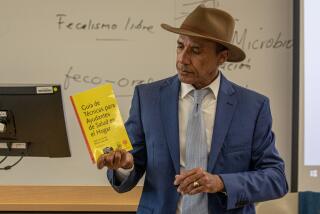Language Students Hone Skills in Space-Age ‘Chat’
- Share via
CARLISLE, Pa. — Classroom instruction in foreign languages has taken a leap into space, in what educators and students hope will be a giant step toward breaking down geographic and cultural barriers to learning.
German language students at Dickinson College, a four-year liberal arts institution with a strong emphasis on language study, recently had an hourlong conversation in German with staff members at the National Maritime Museum in Bremerhaven, West Germany. The talk took place by means of an international satellite transmission that traveled approximately 200,000 miles through space.
The broadcast, the first international satellite transmission in the history of language instruction, was part of a pilot project developed by the National Committee for Internationalizing Education Through Satellites.
The committee, which has its headquarters at the University of Pennsylvania in Philadelphia, is a private, nonprofit corporation made up of 18 experts in the fields of language and international studies, curriculum development, instructional technology, satellite broadcasting and communications law.
“Our aim, in developing this model that employs live interactive satellite telecommunications, is to internationalize education,” said Dr. Thomas Naff, director of the project. “We want to give students an opportunity to experience other cultures while they are still in this country.”
The Dickinson students said they found the experiment both exciting and educational, as well as extremely challenging. The greatest benefit, they said, was in hearing a foreign language as it actually is spoken by natives.
“My professor is a very good professor, but I can understand everything he says all the time because he knows what vocabulary I know, and he speaks slowly and carefully,” said Dickinson sophomore Jane Hastings of Fryeburg, Me.
Freshman Karen Ruocco of Neshanic, N.J., compared the experience to a visualized telephone conversation.
“At first it was strange talking to a television set,” she said, “but after a while you get a sense that people are over there, and you can see them and watch their actual expressions.”
More to Read
Sign up for Essential California
The most important California stories and recommendations in your inbox every morning.
You may occasionally receive promotional content from the Los Angeles Times.











